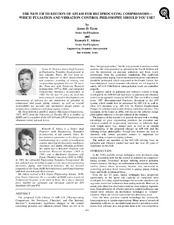| dc.contributor.other | Turbomachinery Symposium (30th : 2001) | |
| dc.creator | Tison, James D. | |
| dc.creator | Atkins, Kenneth E. | |
| dc.date.accessioned | 2017-10-05T00:19:38Z | |
| dc.date.available | 2017-10-05T00:19:38Z | |
| dc.date.issued | 2001 | |
| dc.identifier.uri | https://hdl.handle.net/1969.1/163332 | |
| dc.description | Tutorial | en |
| dc.description | pg. 183-196 | en |
| dc.description.abstract | The proposed Fifth Edition of API 618 (“Reciprocating Compressors for Petroleum, Chemical, and Gas Industry Services”) incorporates significant changes in the section concerning pulsation and vibration control. There are still to be three “design approaches,” but the requirements to perform certain analyses that were presented as optional in the Fourth Edition will now be dependent on pressure pulsation and for levels determined from the acoustical simulation. The confusion concerning when piping forced mechanical response calculations should be performed, which originated in the Fourth Edition, has been eliminated; forced response calculations are not required to satisfy API 618 Fifth Edition when pulsation levels are controlled properly. A separate article on pulsation and vibration control is being developed by the API 618 sub-task force on pulsation and vibration control as an appendix (annex) to API 618. This text will be a stand alone “RP” (Recommended Practices) document in the API system, which would then by referenced by API 618 as well as other API standards (e.g., API 674 for Positive Displacement Pumps) for which pulsation and vibration control are an issue. This document, to be issued in 2002, will discuss the different design philosophies inherent to the new edition of the standard. The purpose of this tutorial is to provide the user with a working knowledge of good engineering practices for pulsation and vibration control of reciprocating machinery in relatively high mole weight gases (e.g., natural gas), as well as an indepth understanding of the proposed changes in API 618 and the differing design philosophies. Several case histories are used to illustrate why robust pulsation control is important for reciprocating compressor piping systems. The authors are members of the API 618 sub-task force on pulsation and vibration control and each has over 20 years of experience in this field. | en |
| dc.format.medium | Electronic | en |
| dc.format.mimetype | application/pdf | |
| dc.language.iso | en | |
| dc.publisher | Texas A&M University. Turbomachinery Laboratories | |
| dc.relation.ispartof | Proceedings of the 30th Turbomachinery Symposium | en |
| dc.subject.lcsh | Turbomachines | en |
| dc.title | The New Fifth Edition Of API 618 For Reciprocating Compressors - Which Pulsation And Vibration Control Philosophy Should You Use? | en |
| dc.title.alternative | New Fifth Edition Of API 618 For Reciprocating Compressors - Which Pulsation And Vibration Control Philosophy Should You Use? | en |
| dc.title.alternative | New 5th Edition Of API 618 For Reciprocating Compressors - Which Pulsation And Vibration Control Philosophy Should You Use? | en |
| dc.type.genre | Presentation | en |
| dc.type.material | Text | en |
| dc.identifier.doi | https://doi.org/10.21423/R1265V | |


